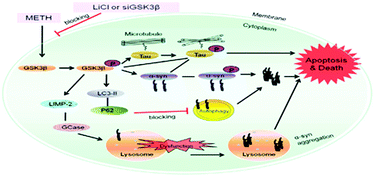当前位置:
X-MOL 学术
›
Toxicol. Res.
›
论文详情
Our official English website, www.x-mol.net, welcomes your
feedback! (Note: you will need to create a separate account there.)
Role of GSK3β/α-synuclein axis in methamphetamine-induced neurotoxicity in PC12 cells
Toxicology Research ( IF 2.2 ) Pub Date : 2017-12-22 00:00:00 , DOI: 10.1039/c7tx00189d Lizeng Li 1 , Si Chen 1 , Yue Wang 1 , Xia Yue 1 , Jingtao Xu 1 , Weibing Xie 1 , Pingming Qiu 1 , Chao Liu 2 , AiFeng Wang 1 , Huijun Wang 1
Toxicology Research ( IF 2.2 ) Pub Date : 2017-12-22 00:00:00 , DOI: 10.1039/c7tx00189d Lizeng Li 1 , Si Chen 1 , Yue Wang 1 , Xia Yue 1 , Jingtao Xu 1 , Weibing Xie 1 , Pingming Qiu 1 , Chao Liu 2 , AiFeng Wang 1 , Huijun Wang 1
Affiliation

|
Methamphetamine (METH) is well-known as a potent psychostimulant of abuse worldwide. METH administration can cause neurotoxicity and neurodegenerative injury, which are similar to the two prevalent neurodegenerative disorders Alzheimer's disease (AD) and Parkinson's disease (PD). Recent results suggested that METH exposure increased the level of α-synuclein (α-syn) that could be a possible cause of neurotoxicity. However, the mechanism of METH-induced neurodegeneration remains unclear. This study was aimed at examining the effects of glycogen synthase kinase3β (GSK3β), α-syn, and tau on METH-induced neurotoxicity. Our results indicated that P-GSK3β (Tyr216), P-Tau (Ser396), α-syn, and P-α-syn (Ser129) levels were increased after METH administration in dose- and time-dependent manners. Upon inhibiting the GSK3β activity with LiCl or GSK3β-siRNA, these protein expressions were significantly decreased. We observed that LiCl protected the cells from METH-caused cytotoxicity by weakening the cell morphological damage and preventing cell apoptosis and death. We also found that P-GSK3β colocalized with P-Tau and α-syn by the immunofluorescence method. Further, METH disrupted the cellular autophagy by upregulation of LC3-II and P62 proteins, and the cellular autophagy was restored by LiCl and GSK3β-siRNA. The expressions of the α-syn-specific degradative enzyme glucocerebrosidase (GCase) with its regulator lysosomal integral membrane protein type-2 (LIMP-2) decreased inversely with the doses of METH treatment. The GCase inhibitor conduritol-β-epoxide (CβE) increased the α-syn levels, and LiCl restored GCase and LIMP-2 expressions disrupted by the METH treatment. In summary, we conclude that GSK3β plays key roles in METH-induced neurotoxicity and neurodegenerative injury by promoting abnormal protein phosphorylation and α-syn accumulation, blocking the autophagy–lysosomal degradation pathway, and finally leading to cell apoptosis and death. GSK3β may be a potential target to prevent METH-induced neurodegeneration.
中文翻译:

GSK3β/α-突触核蛋白轴在甲基苯丙胺诱导的 PC12 细胞神经毒性中的作用
甲基苯丙胺 (METH) 是一种全世界范围内滥用的强效精神兴奋剂。服用冰毒可引起神经毒性和神经退行性损伤,这与两种流行的神经退行性疾病阿尔茨海默病(AD)和帕金森病(PD)类似。最近的结果表明,接触冰毒会增加 α-突触核蛋白 (α-syn) 的水平,这可能是神经毒性的一个原因。然而,METH 引起的神经退行性变的机制仍不清楚。本研究旨在探讨糖原合成酶激酶 3β (GSK3β)、α-syn 和 tau 对 METH 诱导的神经毒性的影响。我们的结果表明,服用 METH 后,P-GSK3β (Tyr216)、P-Tau (Ser396)、α-syn 和 P-α-syn (Ser129) 水平以剂量和时间依赖性方式增加。用 LiCl 或 GSK3β-siRNA 抑制 GSK3β 活性后,这些蛋白表达显着降低。我们观察到,LiCl 通过减弱细胞形态损伤并防止细胞凋亡和死亡,保护细胞免受 METH 引起的细胞毒性。我们还通过免疫荧光方法发现P-GSK3β与P-Tau和α-syn共定位。此外,METH通过上调LC3-II和P62蛋白破坏细胞自噬,而LiCl和GSK3β-siRNA恢复细胞自噬。 α-syn 特异性降解酶葡萄糖脑苷脂酶 (GCase) 及其调节剂溶酶体整合膜蛋白 2 型 (LIMP-2) 的表达与 METH 治疗剂量成反比下降。 GCase 抑制剂 conduritol-β-epoxy (CβE) 增加了 α-syn 水平,LiCl 恢复了 METH 处理破坏的 GCase 和 LIMP-2 表达。 综上所述,我们得出结论,GSK3β通过促进异常蛋白磷酸化和α-syn积累,阻断自噬-溶酶体降解途径,最终导致细胞凋亡和死亡,在METH诱导的神经毒性和神经退行性损伤中发挥关键作用。 GSK3β 可能是预防 METH 引起的神经变性的潜在靶点。
更新日期:2017-12-22
中文翻译:

GSK3β/α-突触核蛋白轴在甲基苯丙胺诱导的 PC12 细胞神经毒性中的作用
甲基苯丙胺 (METH) 是一种全世界范围内滥用的强效精神兴奋剂。服用冰毒可引起神经毒性和神经退行性损伤,这与两种流行的神经退行性疾病阿尔茨海默病(AD)和帕金森病(PD)类似。最近的结果表明,接触冰毒会增加 α-突触核蛋白 (α-syn) 的水平,这可能是神经毒性的一个原因。然而,METH 引起的神经退行性变的机制仍不清楚。本研究旨在探讨糖原合成酶激酶 3β (GSK3β)、α-syn 和 tau 对 METH 诱导的神经毒性的影响。我们的结果表明,服用 METH 后,P-GSK3β (Tyr216)、P-Tau (Ser396)、α-syn 和 P-α-syn (Ser129) 水平以剂量和时间依赖性方式增加。用 LiCl 或 GSK3β-siRNA 抑制 GSK3β 活性后,这些蛋白表达显着降低。我们观察到,LiCl 通过减弱细胞形态损伤并防止细胞凋亡和死亡,保护细胞免受 METH 引起的细胞毒性。我们还通过免疫荧光方法发现P-GSK3β与P-Tau和α-syn共定位。此外,METH通过上调LC3-II和P62蛋白破坏细胞自噬,而LiCl和GSK3β-siRNA恢复细胞自噬。 α-syn 特异性降解酶葡萄糖脑苷脂酶 (GCase) 及其调节剂溶酶体整合膜蛋白 2 型 (LIMP-2) 的表达与 METH 治疗剂量成反比下降。 GCase 抑制剂 conduritol-β-epoxy (CβE) 增加了 α-syn 水平,LiCl 恢复了 METH 处理破坏的 GCase 和 LIMP-2 表达。 综上所述,我们得出结论,GSK3β通过促进异常蛋白磷酸化和α-syn积累,阻断自噬-溶酶体降解途径,最终导致细胞凋亡和死亡,在METH诱导的神经毒性和神经退行性损伤中发挥关键作用。 GSK3β 可能是预防 METH 引起的神经变性的潜在靶点。











































 京公网安备 11010802027423号
京公网安备 11010802027423号